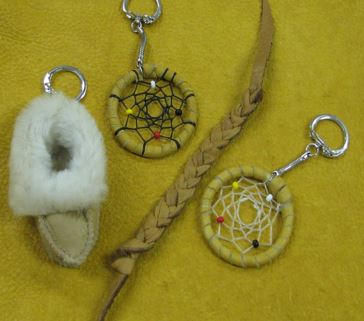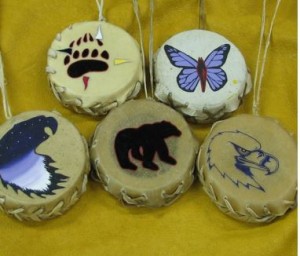(Images from products made at the Warkworth Institution’s ‘Native crafts’ workshop. Photos from a product website)
Jorge Barrera
APTN National News
A Cree-Metis artist says a federal prison corporation program aimed at Indigenous inmates to produce moccasins and drums for revenue is “exploitative” and needs a serious overhaul.
Dawn Marie Marchand, a Cold Lake First Nation and Metis artist, said she was extremely concerned after discovering a corporation run by Correctional Service of Canada (CSC) was producing moccasins and drums, among other items, marketing them as being handcrafted by Indigenous peoples and then selling them to stores.
“This is exploitative,” said Marchand, in an interview with APTN National News. “It really shows a lack of respect both for the local nations that are around there, but also for the local artisans that are there and the people who actually do this work and put pride, energy and time into this work. They need somebody to tell them or show them how to do it properly.”
Marchand was responding to a report which aired last Thursday on APTN’s political program Nation to Nation describing a prison workshop at the Warkworth Institution, in Campbellford, Ont., which produces an assortment of items marketed as being “handcrafted by Canada’s First Nations, Inuit and Metis people” through CSC’s internal corporation of CORCAN. CORCAN earns tens of millions of dollars in revenue a year by selling inmate manufactured products and services.

While the Nation to Nation report focused on the recording of “racially prejudicial” comments by a top official at a major Canadian think tank involved in developing a training program for Indigenous inmates for CORCAN, Marchand said she was struck by the corporation’s selling of Indigenous-associated items made by Indigenous inmates.
She fired off a series of tweets about the issue shortly after viewing the episode online which featured recorded statements from Michael Bloom, a vice president of the Conference Board of Canada, where he made racialized generalizations about Indigenous peoples, Asian people, and the Caribbean community.
“This is completely unacceptable,” tweeted Marchand, who goes by the handle @Cree8Dawn. “Firstly the use of Indigenous inmates 2B providing ‘Slave Labour’ for profit in the prison industrial complex.”
Marchand, who at one point used the hashtag #DISGUSTING, tweeted that she’s worked for 12 years promoting Indigenous hand crafts as an art form shaped by territory, clan and family.
by having #Indigenous inmates make moccasins and dreamcatchers for profit in prison work farms.
DO YOU SEE THE CHECKMARK? #DISGUSTING— Dawn Marie (@Cree8Dawn) November 12, 2016
“I’m really not pro pan-Indianism and what pan-Indianism is when we try to lump all nations into one specific category. This is, quote, Native American design, when it actually has nothing to do with what we are actually doing,” said Marchand. “If you want to know what our people are doing you need to go to places where you can find it. You have to go to art markets. Challenge yourself to go to a pow wow. You want to see what people are really doing? That’s where you need to go.”
Marchand said the attempt at mass production by the prison shop undermines the work of actual artisans who kept the art alive.
“When you see this kind of work that has been mass produced in this way it actually creates problems for people who have maintained and kept the spirit of this work alive for many, many generations,” said Marchand. “What bothers me the most is it is being mass produced, meaning it is void of any of the cultural markers, where it’s from, who made it…. These artists that I know, they hand-make and they hand-bead and they do all kinds of work. It takes a long time to do it properly.”
The Warkworth Native craft, fur and shearing shop began operating in earnest in 2009 and was designed as an “Aboriginal program,” according to Karl Lech, the program instructor. Lech said it was preceded by a fur trapping course which was discontinued after one year. He doesn’t know why the trapping course was dropped.
Lech said the program began by making fur trimmed sheepskin mitts which first sold within the department and then to stores in Ontario. By about 2010, Lech said the stores suggested the workshop expand its products to include moccasins and drums.
“They said, hey, this might be an idea for you. The guys might like to try this,” he said. “A lot of them really enjoy doing moccasins. Not only that, it teaches them a lot of hand-stitching techniques too. They get to use scissors, they get to use fur knives. They get to use a lot of different tools.”
Lech said it gives the Indigenous inmates a chance to learn skills they could use to start their own business when they get out of prison.
“I had a couple of them say, ‘This is really neat, when I get out I’d like to make my family some moccasins,’” said Lech, whose family has been involved in the fur industry for over a century. “It’s perfect, it gives them some tools and they can do it. They can make a little extra money on the side when they get out. They can set up their own business.”

Greg Harris was one of those inmates. The Cree man worked in the workshop in 2010 and when he got out the next year he ended up starting up his own store in North Bay, Ont., now known as Native Creations. Harris said he started out with only $1,000, did the rounds of craft shows and built up his business from there. He now purchases products from the Warkworth shop he sells in his store.
“Well, it’s not slave labour. They are learning something on the inside and at the same time, when we’re there, we still get paid, but it’s not that much,” said Harris. “It gives us extra money to live on. And, instead of being locked up in your cell all the time, you are making a trade out of it.”
He believes the program should be expanded.
“It changed my whole life around,” said Harris. “I would be back getting into trouble and getting back inside.”

Inmates working at the shop get paid up to $6.90 a day for their work. Lech said he only allows non-Indigenous inmates to enter the program if he’s exhausted the waiting list.
A price list of items produced by the shop from 2014 shows inmates there make about 25 different items, from mitts to drums, to moccasins to dream-catcher key chains. The price list was obtained by Jean-Philippe Crete, a visiting junior fellow at the Centre for Criminology and Socio-legal Studies at the University of Toronto.
The shop sells its moccasins, made from cow leather, for $55 a pair, a 15 inch drum, made with Elks skin and cypress wood, for $100 and dream-catcher key chains for $3 each, HST included. Other products include mitts for $70, headbands for $75 and moccasin key chains for $3, HST included.
Lech said the price of items is set to recover the cost of materials and tools. The workshop, which can employ up to 11 inmates, produces about 250 pairs of moccasins and up to 60 drums a year, he said.
CORCAN’s full slate of products and services is projected to generate about $90 million in gross profits by the end of the 2017 fiscal year.
Harris said he re-sells moccasins, which do not include beads, from the CORCAN workshop for $89.95 and the 15 inch drums for $169.
Harris said he doesn’t believe he is underselling his competitors in North Bay who sell similar moccasins for $94 with beads.
Since it began its expanded product line, the Warkworth shop has sold its products primarily to stores in Ontario in places like Curve Lake, Rama, Six Nations, Gananoque and North Bay along with the Correctional Service Museum in Kingston and the Canadian Canoe Museum in Peterborough.
It also sold four Inuit hand drums to the Museum of Canadian History in Gatineau, Que. The museum still has two of the drums in stock at its gift shop, said a spokesperson for the museum.
Lech said he puts a little tag on products like the moccasins that read, “Handcrafted by Canada’s First Nation, Inuit and Metis people.”
CORCAN does not advertise the Warkworth shop’s Native crafts products on its website among its other products and services, which include bunk beds, office stationary and military vehicle repairs.
A website hosted out Warkworth does advertise the line of products, but, despite the Correctional Service of Canada banner, it is not an official government website. Lech said the website is out of date and he is not really sure why CORCAN does not advertise its moccasins and drums on the main website.
For Crete, he sees the items as products of “pain.” Crete, who is also a doctoral candidate at the University of Alberta, said the items are the result of the “mass incarceration” of Indigenous peoples.
“Pain is imprisonment. Pain is losing your right of liberty,” said Crete, who has written papers and given talks about the colonial legacy of the penal system while using the Warkworth shop as one example. “It is problematic that the state is hiring prisoners to reproduce sacred objects of their own culture and selling it to mass markets.”
Crete first discovered the Warkworth products while he worked for Correctional Service of Canada. He received an email around Christmas time urging employees to go to national headquarters and purchase gifts to be given under the tree.
“So they set up a display at national headquarters and you could go and purchase these items. I found it very curious and a little troubling when I found out CORCAN was also now in the business of reproducing Aboriginal artifacts on mass,” he said.
Crete traces the roots of this program to CSC’s reaction to the Supreme Court of Canada’s 1999 Gladue decision. The decision outlined the need for judges, when sentencing, to take into account an Indigenous offender’s specific background and the systemic injustice they’ve faced.
Crete said CSC concluded it needed to teach Indigenous peoples their own culture so they would stop reoffending.
“That Gladue report got translated in the prison system under a commissioner’s directive,” said Crete. “(Which) identified those needs in Gladue and applied them as specific target points to intervene in punishment.”
Marchand said if CSC and CORCAN were really serious about providing programming that creates space for Indigenous culture, it should revive the trapping program.
“If you go through the skills of trapping, the skinning, the drying and stretching, that is going to teach you more about being back on the land, learning sustainability, learning how we did things like this. And then you learn how to make your moccasins,” said Marchand. “There is nothing based on the land in supplying some leather and teaching how to do this for a couple of days. It is devoid of the actual land part.”










